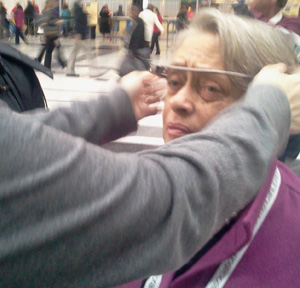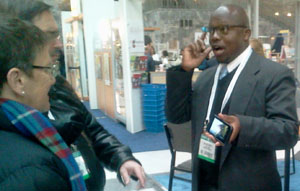
Anyone standing outside on the second day of the 2014 ALA Midwinter Meeting here in Philadelphia was dusted with snow, but the scene inside the Pennsylvania Convention Center was sizzling.
Many of us began gathering right at 9 a.m. Saturday morning for a chance to begin trying demonstration models of Google Glass with a tap of the finger and the spoken command “OK, Glass,” and it was obvious that it wasn’t just the tech crowd that was strongly interested in seeing firsthand, how this wearable technology might be helpful to library staff and library users in everything from reference interactions to training/teaching/learning endeavors.
“I can see where it might be useful in live training sessions,” American Psychological Association Training Specialist Alison Cody observed after trying a Google Glass for a couple of minutes. “When someone asks a question I don’t have an answer for, I could check a website [with the voice-controlled device]. I can see them popping up in learning in two or three years in an unofficial way,” she said, when students and instructors with their own personal devices incorporate them into the learning process.
“They have potential (http://www.google.com/glass/start/how-it-feels/),” Barbara Ford, a professor at the University of Illinois at Urbana-Champaign Library and former 1997–1998 ALA president, agreed, noting that adoption within libraries will depend upon what sort of apps are developed by Google Glass users.
Library users, Ford added, “like to try these new things,” and libraries can play an important role in meeting that need by providing lendable-technology libraries. “We all need to let them try this out. I think that’s part of an education system. You can’t learn stuff in the abstract,” she said. “This is important to the future of libraries—that people see these things used and explored in libraries; there are great opportunities for partnerships here.”
Google representatives clearly agree.
 “Google’s mission has always been to organize all the world’s information and make it universally accessible—which is what libraries do, so we have a shared interest,” Google Glass Public Policy Counsel Wilson White said. Mapping library collections so patrons can find individual items through Google Glass is one of the many ways the device might prove useful, he suggested. What must happen next, he continued, is that Google Glass users need to develop the apps that will build upon the platform Google is providing with this quickly developing wearable technology: ALA Midwinter “is a chance to dream aloud.”
“Google’s mission has always been to organize all the world’s information and make it universally accessible—which is what libraries do, so we have a shared interest,” Google Glass Public Policy Counsel Wilson White said. Mapping library collections so patrons can find individual items through Google Glass is one of the many ways the device might prove useful, he suggested. What must happen next, he continued, is that Google Glass users need to develop the apps that will build upon the platform Google is providing with this quickly developing wearable technology: ALA Midwinter “is a chance to dream aloud.”
ALA’s Office for Information Technology Policy (OITP) has been a partner with Google in providing a venue for conference attendees to pursue that dream, OITP Director Alan Inouye noted: “We’ve been working with Google since 2008 on different things…. For libraries to be ahead of the curve is how we can best serve library users.”
Watching attendees try Google Glass offered intriguing hints of how quickly the project is evolving. Various Google staff members, for example, were actually using different versions (ranging from Version 9 to Version 14), according to one who was helping conference attendees try everything from viewing CNN news clips to viewing New York Times headlines with the device. They were quick to set a context for Google Glass, suggesting that it isn’t designed to replace laptops, tablets, or smartphones, but, rather, to be used in conjunction with them; connecting it to a smartphone, they showed, provides the possibility of projecting an image on the mobile screen of what the Google Glass user is actually seeing. It’s also clear that the device could easily be another way for instructors to reach remote learners by broadcasting training-teaching-learning sessions to them.
Google reps also said Google Glass was designed not to interfere with eye-to-eye contact in its day-to-day use—a goal that a few users confirmed has already been met, and something that has been apparent since the earliest moments that Google Glass prototypes began appearing in public.
More information about the device is available on the Google Glass site.
PAUL SIGNORELLI of Paul Signorelli & Associates is a writer, trainer, social media strategist, and consultant. Email him at paul[at]paulsignorelli.com.
See, hear, and read more about what’s going on at Midwinter—in real time and after.
Twitter: @alamw and #alamw14
Facebook: https://www.facebook.com/events/512164432210368
YouTube: youtube.com/user/AmLibraryAssociation
Flickr: flickr.com/groups/2422196@N23
Pinterest: pinterest.com/alamidwinter


